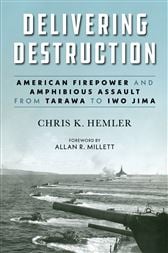
Delivering Destruction; American Firepower and Amphibious Assault from Tarawa to Iwo Jima. By Chris K Hemler. Naval Institute Press, Annapolis, Maryland, 2023
Reviewed by Tim Coyle
Naval strategy and tactics in the years immediately following the end of World War One didn’t change all that much. Sure, German submarines had almost crippled Britain, but aircraft, unlike in the ground war, hadn’t revolutionised the maritime war.
Navies still believed in the power of the big gun and the serried ranks of the battlefleet steaming to the climactic decisive battle. The inconclusive Battle of Jutland hadn’t swayed the British and American admirals; submarines were for scouting ahead of the battle fleets and sinking the enemy’s major units before the main engagement and aircraft, operated from the Washington Treaty-enforced converted aircraft carriers, were also regarded as scouting assets.
If submarines and aircraft were diminished in importance, amphibious warfare was practically a non-starter. Churchill’s Gallipoli campaign of 1915 was initially to force the Narrow by ‘ships alone’. When this failed on 18 March 1915, an amphibious force was thrown together to scale the Gallipoli heights, overcome the Turkish defenders and their forts, and march on Constantinople. The post-war considered opinion was the confirmation of the dictum that a naval assault on a fortified shore was a most difficult prospect – which 18 March confirmed in many naval minds.
The Gallipoli disaster was intensively studied for years afterwards, particularly by some imaginative US Marine Corps officers. Marine corps of several nations believed their elite troops would conduct surprise assaults against key coastal facilities to achieve limited local control. However, some in the US Marine Corps thought more expansively.
The USMC enjoyed a relatively favourable reputation in American government and society. Established in 1834 it had participated in ‘foreign service’ expeditions in the 19th century and had performed creditably in World War One. After the war, the Corps was tasked with planning and force development for amphibious warfare. Significant in this responsibility was planning for War Plan Orange, the naval campaign against Japan.
The two major challenges facing the Marine planners were transportation and landing of the assault force against a defended shore and sustaining a lodgement to allow additional forces and their logistics to land. The Naval War College and the Marine Corps Schools- Quantico studies concluded fortified defences could only be neutralised by high velocity flat trajectory naval guns. Developments in naval aviation extended the assault assets to include precision bombing. This ‘triphibious’ concept required doctrines of coordination and integrated operational staffs which eshewed naval and air ‘tribalism’.
Delivering Destruction discusses how US Marine and Navy officers created the doctrine, techniques, communications, and dedicated personnel that made naval gunfire and close air support the very core of the Pacific war island campaigns.
Chapter 1: ‘Getting the Shells to Fall Where You Want Them; Coordinating Naval Gunfire and Air Support in the Interwar Period ‘ traces the struggle Marine amphibious visionaries pursued to identify practicalities in coordinating supporting firepower. Even though an amphibious component of War Plan Orange was progressed in the interwar years, this was primarily in the ship to shore component which encompassed the design of landing craft. Despite the growing recognition of the importance of supporting firepower, conservative views of naval, air and ground-based fires remained up to the US entry into World War Two. Chapter 1 concludes with the statement: ‘Tragically, this combination of ignorance and insufficient attention left the Americans categorically unprepared, at the outbreak of war, to effectively coordinate and integrate firepower during a contested amphibious assault’.
This unpreparedness was demonstrated at the first test of amphibious assault against the island of Tarawa in November 1943. This assault provided the first live opportunity to put amphibious theory, developed in the interwar period, into practice. Although Tarawa was taken it was at a high cost, caused through exposure of the landing force to defending fire, unsuitable communications equipment, inadequate maps, unrehearsed techniques and unfamiliar inter-serve terminology. The post-operation enquiry found many failures, chief of which was the need for triphibious fire support coordination. This was addressed through the creation of Joint Assault Signals Companies (JASCO) – an administrative headquarters combining subordinate shore fire control, air liaison and communications which trained, organised and deployed as a comprehensive unit.
Leveraging the lessons learnt from Tarawa, USMC-led amphibious planning concentrating on maritime and air fire support led to the cumulative successes in the Marshall Islands, Saipan and Iwo Jima. Despite the overwhelming US personnel and materiel superiorities, these were hard fought against an implacable enemy. Hemler graphically describes the desperate battles on Saipan and the most challenging assault on Iwo Jima. He analyses the progressive streamlining of JASCO and associated formations’ techniques to achieve victory in the island campaigns.
Aside from the Inchon amphibious operation during the Korean War, nothing remotely like the Pacific amphibious assaults has occurred since. However, one contemporary issue looms above all others – the People’s Republic of China’s determination to regain Taiwan ‘by force if necessary’. Strategic and military analysts are canvassing ranges of scenarios in countering such a contingency. While technologies and tactics have changed exponentially since 1945, the lessons learnt in the Pacific War of joint planning and coordination are still relevant. As such, Delivering Destruction is a timely reminder of the complexities of amphibious operations and is worthy of study by planners and operators at all levels of the joint domain.



